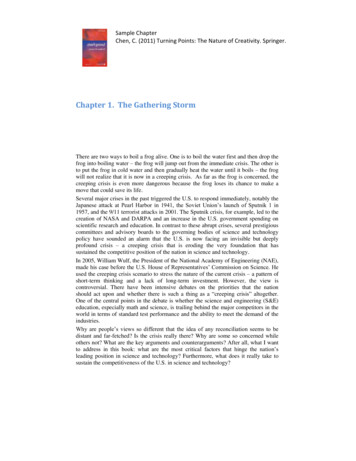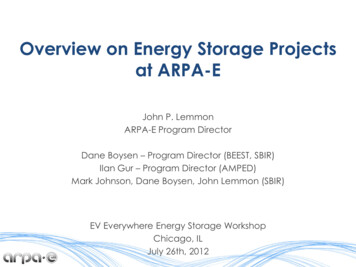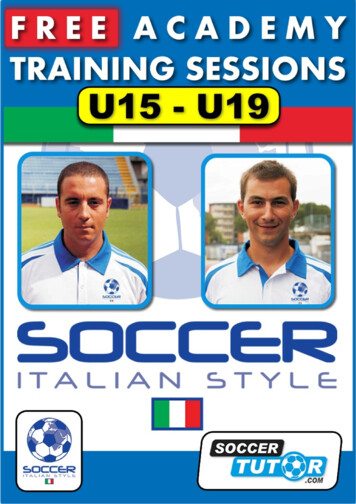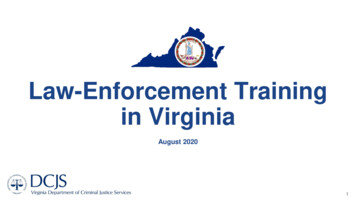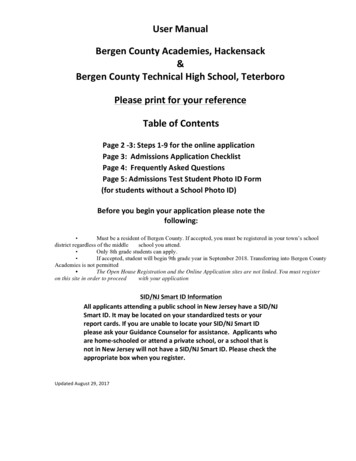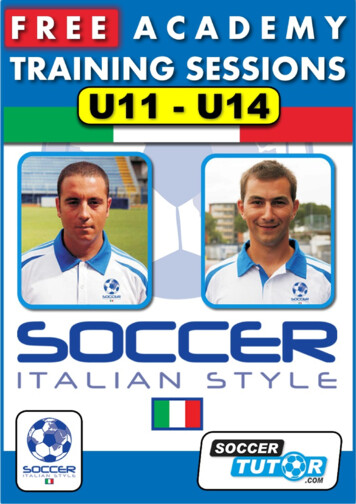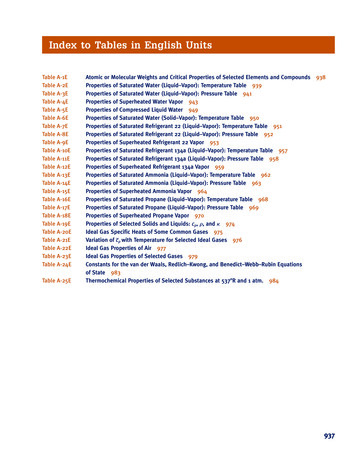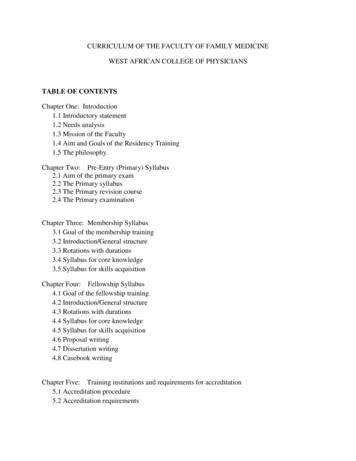
Transcription
CURRICULUM OF THE FACULTY OF FAMILY MEDICINEWEST AFRICAN COLLEGE OF PHYSICIANSTABLE OF CONTENTSChapter One: Introduction1.1 Introductory statement1.2 Needs analysis1.3 Mission of the Faculty1.4 Aim and Goals of the Residency Training1.5 The philosophy.Chapter Two: Pre-Entry (Primary) Syllabus2.1 Aim of the primary exam2.2 The Primary syllabus2.3 The Primary revision course2.4 The Primary examinationChapter Three: Membership Syllabus3.1 Goal of the membership training3.2 Introduction/General structure3.3 Rotations with durations3.4 Syllabus for core knowledge3.5 Syllabus for skills acquisitionChapter Four: Fellowship Syllabus4.1 Goal of the fellowship training4.2 Introduction/General structure4.3 Rotations with durations4.4 Syllabus for core knowledge4.5 Syllabus for skills acquisition4.6 Proposal writing4.7 Dissertation writing4.8 Casebook writingChapter Five: Training institutions and requirements for accreditation5.1 Accreditation procedure5.2 Accreditation requirements
Chapter Six:Assessments6.1 Introduction6.2 Summative Assessments6.3 Formative Assessments6.4 MentorshipAppendices
CHAPTER ONE – INTRODUCTION1.1 Introductory statementFamily medicine is the medical discipline also known as general practice, general medicalpractice, family practice, or primary care. It is a discipline which integrates several medicalspecialties into a new whole. It is concerned with the holistic approach to patient care in whichthe individual is seen in his totality and in the context of his family and community. The traineesin family medicine should be appropriately equipped to meet the contemporary and future healthneeds of individuals and families within their practice community. To meet this demand he needsto have a solid foundation in basic medical education, and acquire knowledge and skills in themajor clinical disciplines with appropriate attitude essential to the practice of the specialty. Thiscurriculum is therefore designed to guide the training of residents in Family Medicine.Family Medicine Practice consists of three Core Areas: Primary Care, Health Facility Care andFamily Care, Fig 1.Primary CareFamilyPhysicianFamily CareHealth FacilityCareFigure 1: Domains of Family Medical Practice and position of Family Physician in the domain.Primary Care consists of two areas of care, primary medical care and primary health care.Primary Medical CareThe term primary medical care here refers to all care delivered at the point of first contact withthe health care system which may be in small clinics, health centres or general practice sectionsof large district hospitals and tertiary centres.Primary Health Care (PHC)WHO defines Primary health care as essential healthcare based on practical, scientifically soundand socially acceptable methods and technology made universally accessible to individuals andfamilies in the community through their full participation and at a cost that the community andcountry can afford to maintain at every stage of their development in the spirit of self-relianceand self-determination (Alma-Ata, 1978). It aims at delivering essential and comprehensivehealth services in an integrated manner to the people at the point of first contact. The practice ofthe Family Physician provides the patient and family access to integrated curative, preventiveand health promotion services.
Hospital and Clinic Care (Facility-based Care)In West Africa, the Family Physician functions as a general physician, with competences insurgery, obstetrics and gynaecology, especially in under-served and difficult-to-reachpopulations. In multi-specialty health institutions the Family Physician coordinates the care forthe patient as he or she navigates the health system while receiving care from many linearspecialists.Family Care and Family DynamicsCentral to the practice of Family Medicine is the understanding of the concept of what the familyis and the important interplay between family dynamics and the health of family members.Hence in Family care the family becomes the unit of care.1.2 Needs analysisMost countries in the West African sub-region parade poor health indices. The resourcesavailable for health in these countries are also very limited. Rural areas, where a large proportionof the people reside, tend to be particularly underserved.It has long been recognized that primary health care is the key to attaining health for all. In theWorld Health Report of 2008 the WHO reviewed the implementation of the primary health careinitiative after 30 years. It noted that in countries that had made significant progress, primaryhealth care was centered around physicians with a specialization in family medicine or generalpractice.In recognition of the unique role that family physicians can play in primary healthcare delivery,the Agenda item 12.4 of the Sixty Second World Health Assembly of 22 May 2009 (WHA62.12)asked member countries to ‘train and retain adequate numbers of health workers, withappropriate skill mix, including primary health care nurses, midwives, allied health professionalsand Family Physicians, able to work in a multidisciplinary context, in cooperation with nonprofessional community health workers in order to respond effectively to people’s health needs’.To bring quality health care closer to the people of West Africa there is the need to produce acritical mass of Family Physicians. Family Physicians will provide healthmaintenance/promotion, disease prevention, basic medical, surgical, paediatric, obstetric andgynaecological care within the community and provide coordination of care in multi-specialtyhealth institutions. Such a physician will manage the total healthcare needs of the patient incollaboration with relevant specialists in the various clinical and allied disciplines. With theinadequate number of Family Physicians, the gap is poorly filled by general duty medicalofficers, subspecialists without postgraduate training in primary care, community health workersand a range of unorthodox practitioners.
1.3 Vision of the FacultyImproved health and quality of life of the West African people through fostering and maintaininghigh standards in family medicine training, practice, and research.1.4 Mission of the FacultyTo produce Family Physicians of international standards who are equipped with the knowledge,skills and attitudes needed to practice, teach, and conduct research competently in the sub-regionand play key leadership roles in providing comprehensive health services that meet the needs ofthe individuals and families within the context of the communities they serve. It is hoped that inthe foreseeable future all primary care providers in the West African sub-region are specialists inFamily Medicine.1.5 Aim and Goals of the Residency Training ProgrammeThe Goal of the training programme is to produce Family Medicine Specialists of internationalstandard who can meet the peculiar health needs of the West African People. At the end of thetraining the graduate of the programme will be able to:A. Practice competently the field of Family medicine at the primary care, family care andinstitutional care levels.B. Provide leadership for other health workers in his team for effective service deliveryC. Coordinate health care services and programmesD. Manage health resources and institutions for efficient service delivery.E. Manage training programmes to train Family Physicians and other relevant health workersF. Initiate and conduct relevant research to improve practice and contribute knowledge to thespecialty.G. Play appropriate advocacy role for improved health and quality of life for people in hispractice community in cooperation with other community health providers and stakeholders.1.6 The Philosophy of the Training Programme.Family medicine started at the very beginning of the evolution of medical practice. The firstphysicians were generalists and for thousands of years, generalists provided all of the medicalcare available. They diagnosed and treated illnesses, performed surgery, and delivered babies.As medical knowledge expanded and technology advanced, many physicians chose to limit theirpractices to specific, defined areas of medicine. With time specialization began to flourish and
the number of specialists and subspecialists increased at a phenomenal rate, while the number ofgeneralists declined dramatically.In many countries the public became increasingly vocal about the fragmentation of their care andthe shortage of personal physicians who could provide holistic, continuing and comprehensivecare. Thus began the reorientation of medicine back to personal, primary care. The concept of thegeneralist was reborn with the establishment of family medicine as a specialty in many countries.The countries in Africa are at different stages of this evolutionary process.Arising from this historical background, the philosophy of the residency training in FamilyMedicine is therefore to produce a well-grounded medical specialist of first contact that willprovide high quality health care at the grassroots and serve as an efficient gate keeper to thehealth system.The product of the programme will be a thorough bred clinician, a teacher, a counselor, amanager, a team leader, a researcher and a health advocate. He will have to recognize thecommon health problems in his practice community, manage most of them and refer the restappropriately with a view to ensuring efficient utilization of health resources.He will provide personalized, comprehensive, and continuing care to individuals and families inthe community from cradle to grave. He will not only diagnose and treat diseases but will gofurther to explore the subjective aspects of the patient’s unique illness experience in order toprovide holistic care and enhance patient satisfaction. This requires commitment to a long lastingpatient – physician relationship that will provide a thorough knowledge of the patient within thecontext of his family and the larger sociocultural environment.Hence the breadth of this curriculum will be determined by “most of the health problems thatmost of the people have most of the time” rather than by age, gender or organ system.When referral is indicated, he will refer the patient to other specialists or caregivers but willremain the coordinator of the patient’s health care in order to prevent fragmentation of that care.The family physician will serve as the patient’s advocate in dealing with other medicalprofessionals, third party payers, employers and others, and as such serve as a cost-effectivecoordinator of the patient’s health service needs.The knowledge, skills and attitudes prescribed in this curriculum will form the basis of histraining and certification even though the content of his practice will vary with the needs of hispractice community. The scope of the family physician's practice will also change over time,requiring maintenance of competency in current skills and the need to acquire new knowledgeand skills through continuing medical education.The continuous growth in medical knowledge confers on the family physician a responsibility
for life-long learning, as the scope of family medicine is dynamic, expanding, and evolutionary.The training will be of international standard with appropriate consideration for the peculiarneeds of the sub-region and will be conducted in accredited health institutions within the subregion while encouraging exposure outside the sub region where possible and appropriate. Thetrainee will be taken through basic medical sciences, rotations in major clinical disciplines,rotations in rural practice and practice management, engagement in research as well as trainingin medical ethics, education methodology and other relevant subjects.Formative and summative assessments will be carried out to ensure that the certified traineemeets the standards envisaged by the training programme.Structure of the Residency ProgramAdmission into Residency Program:The program shall be open to candidates who:1.possess an MBBS, MBCHB or equivalent from an approved University.2.have completed a minimum of 12 months rotatory internship in an accredited hospitalpost university degree.3.possess a valid Medical and Dental Council full Registration as a Medical Practitionerin the relevant constituent member country of West Africa.4.Have passed the Entry Examination (Primary) of the West African College ofPhysicians or equivalent body in Family Medicine.To be exempted from the entry examination candidate should possess MSc (FamMed), or M.FamMed, or equivalent degree acceptable by the College.Membership training: The candidates must serve a minimum of two years in approved trainingposts covering a wide range of practical experience, including posts in internal medicine,surgery, obstetrics and gynaecology, paediatrics and community health. In addition, candidateswill undergo course work, at accredited regional workshops on Principles of family Medicineand Health System Management and Organisation. After the minimum period of two years, andwith satisfactory coverage of the curriculum, the candidate shall be eligible to sit theMembership examination.Fellowship training: After passing the Membership examination, candidates will be required towork for a minimum of two years in a Family Medicine centre approved by the faculty board fortraining. During the two years the candidate will prepare a dissertation on a topic of his choiceand a case book of 15 well-reviewed cases managed by him. These cases are intended todemonstrate the broad base of competencies expected of the trainee.When entering for the fellowship examination, the candidate must:1. have been registered with the faculty for a minimum of 4 years,2. have passed the membership examination at least 2 years before applying for thefellowship examinations
3. show evidence of having satisfactorily served for at least two years in an approved part IItraining centre,4. have submitted a dissertation and a case book,5. Show evidence of attendance of at least one update course and one revision course; andin addition a course in Research methodology and Health System management andOrganisation.6. Show evidence of a 3 month tutelage in private practice management and a 3 month postmembership rotation in an accredited rural surgical practice. This is to acquire practicalmanagement skills and consolidate surgical skills in order to be able to meet the needs atthe grassroots.A period abroad in an area of subspecialisation in Family Medicine will be beneficial inenriching the quality of patient care and practice management in our environment. Thereforeelective periods overseas, of up to one year duration, may be allowed by the Faculty in additionto the two years of Fellowship Training. On completion of two years, the Trainer will sign aCompletion Certificate. The candidate will then forward his Dissertation and Casebook to theCollege Secretariat.
CHAPTER TWO – PRIMARY SYLLABUS2.1 Aim of the primary examThe Primary examination is a screening examination aimed at determining the suitability of thecandidate in knowledge to pursue residency training in Family Medicine. The candidate is todemonstrate a good grounding in basic medical sciences and bio-psychosocial concepts relevantto the common conditions encountered in Family Medicine.2.2 The Primary syllabusAnatomyAim:To demonstrate knowledge of applied gross and microscopic anatomy relevant to the practice ofFamily MedicineCompetencies and Course Contents:Candidate should be able to describe, illustrate and discuss the clinical significance of the grossand microscopic anatomy of the following areas:-Normal body structure, Surface anatomy, Skeletal system, Muscular system, Nervous system,-Cardiovascular system, Respiratory system, Genitourinary system and Gastrointestinal system,-Microscopic anatomy of the basic tissue elements, epithelium, connective tissue.PhysiologyAim:To demonstrate knowledge of normal physiologyCompetencies and Course Contents:Candidate should be able to discuss the normal functioning of the following body systems anddescribe the clinical consequences of derangement in their normal physiology:-Blood, Heart, and Circulation; Fluid and electrolyte physiology; Respiratory Physiology-Digestive System; Regulation of Metabolism; Physiology of the Kidneys; Reproduction;-Immune System; Nervous systemNutritionAim:To demonstrate knowledge of nutritionCompetencies and Course Contents:Candidate should be able to describe, illustrate and discuss
-Normal nutritional requirements; causes, prevention and management of malnutrition-Nutritional value of common foods including human breast milk;-Nutritional and immunological properties of human breast milk;-Comparison of the composition of human breast milk and that of cow’s milk;-Infant feeding;- Complementary diet.BiochemistryAim: To demonstrate knowledge of basic biochemistryCompetencies and Course Contents: Candidates should be able to-Discuss the structure and functions of proteins and enzymes-Discuss the structure, function and replication of nucleic acids-Discuss and illustrate the metabolism of proteins, and amino acids-Discuss the metabolism of carbohydrate, fat, andhaemoglobin.-Discuss the functions and clinical significance of vitamins and minerals-Discuss the clinical significance of deranged metabolismFoetal development (Embryology)Aim: To demonstrate knowledge of normal foetal development and its clinical relevanceCompetencies and Course Contents: Candidates should be able to-Describe the process of development, including gametogenesis, fertilization; foetal developmentand growth.-Enumerate and discuss factors that affect normal embryogenesis e.g. nutritional, endocrine,pharmacologic, infections, occupational, clinical and intrinsic factors (e.g. twinning, anaemia,etc.).Genetics and GenomicsAim: To demonstrate basic knowledge of Genetics and its clinical application.Competencies and Course ContentsCandidates should be able to discuss the following:Mendelian genetics, molecular, physical and biochemical basis of inheritance, chromosomalaberrations. Common genetic problems and syndromes (e.g. haemoglobinopathies, Down’s andTurner’s syndrome etc.). Basic genetic counselling (e.g. premarital counselling on sickle celldisease, counselling on risks of other genetic diseases etc.).Human DevelopmentAim:To demonstrate knowledge of Human physical and psychological developmentCompetencies and Course Contents:Candidates should be able to describe and discuss the following:
Development at the various stages of infancy, childhood, adolescence, maturity and adulthoodincluding Physical, Intellectual and psychological developmentPersonality formation, personality types and personality disorders; Normal sleep and sleepdisorders; Grief reaction; Ageing and senility; Human sexuality and related disordersPharmacologyAim: To demonstrate knowledge of pharmacology relevant to drugs commonly used in Primarycare.Competencies and Course ContentsCandidates should be able to discuss the following:Basic pharmacokinetics- absorption, distribution, metabolism, and excretion of drugs. Basicmechanisms of drug action. Indications for common classes of drugs, including dosages, sideeffects, and drug interactions. Principles of Essential Medicines list. Drug use in liver and kidneydiseases, pregnancy, breast feeding, elderly. Rational use of Medicines.Pathology - Morbid, Chemical Pathology, Microbiology, Immunology, Parasitology,HaematologyAim: To demonstrate knowledge of the pathological basis of common problems seen in FamilyMedicine.Competencies and Course Contents:Candidates should be able to-discuss the pathophysiology and pathological changes in common conditions seen in FamilyMedicine including infections and infestations, endocrine and metabolic disorders, degenerativeconditions; Principles of neoplastic transformation, genetic-metabolic transformation concept ofcarcinogenesis.-discuss how to carry out common point of care tests-interpret common tests of body function-discuss blood group physiology and its clinical applicationForensic MedicineAim:To demonstrate awareness of the Ethical and Legal issues in Medical PracticeCompetencies and Course Contents:Candidates should be able to outline ethical considerations in day to day practice, cases of assaultand sexual offences, consent and confidentiality; concept of vulnerable groupsIntroduction to Family MedicineAim:To demonstrate awareness of family medicine as a specialty and family as a health resource andunit of careCompetencies and Course Contents:Candidates should be able to briefly discuss the following:
Scope of family medicine, Basic principles of family medicine, Family structure, basic familytasks and functions, Influence of the family in health and diseaseMedical InformaticsAim: To demonstrate awareness of analytic tools in the production, control, analysis and decisionmaking with medical dataCompetencies and Course Contents:Candidates should be able to briefly define or explain the following:-basic descriptive statistics i.e. rates, ratios, mean median, mode etc.-vital and health statistics and their importance- Use of ICT tools in medical information and clinical decision support2.3 The Primary revision courseThe Faculty will organize revision course from time to time on the primary syllabus. This willcover major aspects of the syllabus as much as possible and showcase the format of theexamination questions for candidates to be familiar with. This will be through on site or distancelearning programmes.2.4 The Primary examination shall consist of multiple choice questions with single bestanswer.The pass mark shall be 50%.2.5 Recommended textbooks and reference materialsClinical Anatomy by Harold EllisGanong’s review of Medical PhysiologyLangman’s Medical EmbryologyGuyton and Hall Textbook of Medical PhysiologyHarper’s BiochemistryClinical Pharmacology made ridiculously simpleHandbook of family medicine by Bob MarshHandbook of training in Family Medicine – WACP publicationWACP prospectus
CHAPTER THREE: MEMBERSHIP SYLLABUS3.1 Goal for the membership trainingTo produce a physician that is well equipped with basic knowledge, skills and attitude to practiceas a specialist in Family Medicine as well as have a solid foundation for the fellowship trainingin Family Medicine.3.2 Introduction/General structureThe membership training builds on the basic medical training of the first degree and theinternship training. It takes place in accredited health institutions and lasts a minimum of twoyears. During the period the trainee shall go through rotations and be certified in the majorclinical specialties including Family Medicine. He shall also complete prescribed course workorganized by the College and Faculty at Workshops, Update courses and Revision courses.3.3 Rotations with durationThe following rotations and durations are to be considered the minimum acceptablerequirements. The stated durations are for the structured posting. It is expected that the traineewill have continuous exposure to clinical activities in these areas throughout the membershiptraining period. In recognition of the fact that some practice settings do not offer such integratedservice opportunities, the following minimal durations of postings are recommended. Theduration may be increased by the Family medicine trainer to achieve the recommendedcompetencies.Family MedicineSurgeryMaternal HealthInternal MedicineMental HealthChild HealthAccident and y Medicine and PHCENTHaematology and blood transfusionChemical Pathology3 months3 months3 months2 months2 months2 months2 months4 weeks4 weeks4 weeks4 weeks4 weeks2 weeks2 weeks
HistopathologyMicrobiology and Parasitology2 weeks2 weeksOral health2 weeks3.4 Syllabus for core knowledgeFamily medicineAim: To demonstrate knowledge of the core principles of Family Medicine which should guidethe approach to all patients irrespective of the disease the patient presents with.Objectives and learning outcomes:Introduction to Family MedicineThe resident should be able to:Define Family medicine, list the essential attributes of the family physician and discuss the roleof the Family physician in health care delivery.Define the family, describe family types, list the attributes of families and describe basic familytasks.Discuss the influence of the family on the health of its members and vice versaDiscuss General system theory and Family systems theory.Describe Family lifecycle, Family circle, Family genogram and Family developmental stagesDiscuss Family dynamics in health and disease.Describe Family-centred care –including the young family, the middle years, the aging family,abuse and domestic violence, and the elderly,Discuss Communication in family medicine.Discuss the role of Spirituality in health and disease and describe Spiritual assessment.Discuss referral in Family practice.Lifestyle medicineThe resident should be able to discuss the following and their application in family practice: Fitness and wellness concept. Life style factors and their effects on health. Counselling for lifestyle modification. Prescription of physical activity and exercise. Factors that promote adoption and practice of health promoting lifestyles. Lifestyle changes in common disease condition Digital lifestyle and its effect on health.Palliative careThe trainee should be able to define and discuss the following: Palliative care and its objectives Palliative care package – clinical, spiritual, and end of life care as well as bereavementmanagement. Care of the terminally ill.
Palliative care delivery sites, multidisciplinary approach to palliative care and tools forpalliative careGenerational MedicineThe trainee should be able to define and describe the components of the following: Adolescent HealthMen’s HealthWomen’s HealthCare of the Elderly.Recreational/Sports MedicineThe trainee should be able to discuss the following: Fitness for sport and other physical activities.Prohibited substances and medications in sports.Common sports injuries – bruises, lacerations, fractures.Travel MedicineThe trainee should be able to describe how to conduct the following: pre-travel assessment of the travellerassessment of travel itinerarytravel care plan including education, vaccine prescription and chemoprophylaxis, healthinsurance.post-travel assessment including illness identification, management and referral.Teaching methods: Bedside teaching during clinical rotations, Lectures, tutorials, seminars, Casepresentation, Problem based learningFormative assessment: Log book assessments, Mini clinical examination (MiniCEX),presentation feedback assessment, trainee weekly record form, trainee portfolio, mockexaminations.Terminal assessment: End of posting examinationRecommended books and reference materials:Bratton’s Family Medicine Board ReviewTextbook of Family medicine – RakelManual of Family Practice – Robert B TaylorCurrent diagnosis and treatment in Family Medicine
Swanson family practice review: a problem oriented approachEmdexThe Merck manualSouth Africa manual of family medicineInternal medicineAim: To demonstrate a thorough grounding in the principles and practice of adult internalmedicine.Objectives and learning outcomes:Respiratory MedicineThe resident should be able to-discuss common symptoms, signs, and investigative modalities in respiratory diseases.-Define the condition and describe the aetiology, pathophysiology, clinical and laboratoryfeatures, diagnosis, treatment and prevention of common respiratory conditions in primary caresuch as:Pneumonia, Chronic obstructive pulmonary disease, lung-abscess and asthma, upper respiratorytract infections.Cardiovascular disease medicineThe resident should be able to-discuss common symptoms, signs, and investigative modalities in cardiovascular diseases.-Define the condition and describe the aetiology, pathophysiology, clinical and laboratoryfeatures, diagnosis, treatment and prevention of common cardiovascular conditions in primarycare such as:hypertension, left ventricular failure and acute pulmonary oedema, Congestive cardiac failure,cardiomyopathy, ischaemic heart diseases, Venous thrombosis, Arterial peripheral vasculardisease, valvular heart diseaseGastroenterologyThe resident should be able to-discuss common symptoms, signs, and investigative modalities in gastrointestinal diseases.-Define the condition and describe the aetiology, pathophysiology, clinical and laboratoryfeatures, diagnosis, treatment and prevention of common GIT conditions in primary care suchas:Acute gastro-enteritis, cholera, chronic diarrhea, dysentery, irritable bowel disease, infectivehepatitis, liver cirrhosis, amoebic liver abscess, Acid related diseases (GERD, PUD),inflammatory bowel diseases
Endocrinology and MetabolismThe resident should be able to-discuss common symptoms, signs, and investigative modalities in endocrine diseases.-define the condition and describe the aetiology, pathophysiology, clinical and laboratoryfeatures, diagnosis, treatment and prevention of common endocrine and metabolic conditions inprimary care such as:Diabetes mellitus, thyroid diseases, metabolic syndrome, overweight and obesity, disorders ofcalcium metabolism, Cushing’s diseaseNeurologyThe resident should be able to-discuss common symptoms, signs, and investigative modalities in neurological diseases.-define the condition and describe the aetiology, pathophysiology, clinical and laboratoryfeatures, diagnosis, treatment and prevention of common neurological conditions in primarycare such as:Headaches, stroke, seizure disorders, neuralgia and peripheral neuritis, head injury, nerve palsies,Parkinson’s disease, dementia.NephrologyThe resident should be able to-discuss common symptoms, signs, and investigative modalities in renal diseases.-define the condition and
Central to the practice of Family Medicine is the understanding of the concept of what the family is and the important interplay between family dynamics and the health of family members. Hence in Family care the family becomes the unit of care. 1.2 Needs analysis Most countries in the We

